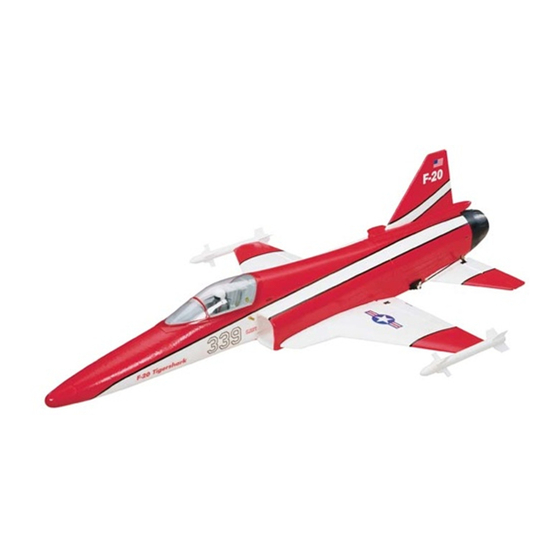GREAT PLANES EP F-20 Tigershark ElectriFLy Руководство по эксплуатации - Страница 15
Просмотреть онлайн или скачать pdf Руководство по эксплуатации для Игрушка GREAT PLANES EP F-20 Tigershark ElectriFLy. GREAT PLANES EP F-20 Tigershark ElectriFLy 16 страниц.

IMPORTANT: Confi rm that the transmitter operates the
controls properly by moving the sticks and watching the
surfaces respond.
When you're ready to launch, have your assistant hold
the F-20 EDF ARF behind the C.G above the wing for
an underhanded toss or behind the TE of the wing for an
overhanded toss. Practice the throwing motion and choose
the method that best suits the person launching the model.
Line up the model so that the nose is pointed directly into the
wind. Advance the power to full and have your assistant toss
the model into the air with a slightly nose-up attitude. Be
ready on the controls to make the corrections necessary to
build up speed while maintaining a wings-level attitude.
When the model has gained adequate fl ying speed under its
own power, gently pull the elevator stick back until the airplane
starts a gradual climb. If you notice the model losing speed,
release the elevator stick and allow the model to gain airspeed
before climbing out. Continue a gradual climb and establish a
gentle turn (away from yourself and others) until the airplane
reaches an altitude of 20 to 30 meters [75 to 100 feet].
The main purpose of the fi rst few fl ights is to learn how the
model behaves and to adjust the trims for level fl ight. After
the model has climbed to a safe altitude, reduce the throttle
slightly to slow the model, yet maintain altitude. The F-20
EDF ARF should fl y well at about 1/2 throttle.
Flight
Name
Address
City
State
Phone #
AMA #
Make a copy of this identifi cation tag
and put it on or inside your model.
Adjust the elevator trim so the model fl ies level at the throttle
setting you are using. Adjust the aileron trim to level the wings.
It may take a few minutes to get the trims adjusted, but this
should be your fi rst priority once at a comfortable altitude.
Continue to fl y around, executing turns and making mental
notes (or having your assistant take notes for you) of what
additional adjustments or C.G. changes may be required to
fi ne tune the model so it fl ies the way you like. Try some
slow fl ight and standard stalls to familiarize yourself with the
airplane's slow-speed handling characteristics. When you
are comfortable, try making a few practice approaches.
To minimize wear and the possibility of damage, choose
a grass runway that is fl at and free of deep ruts. Bring the
power back to about 1/2 stick of throttle and turn downwind
(keeping your current traffi c pattern in mind). Maintain your
speed and altitude during your downwind leg and turn to
base. Start a descent and throttle back a few clicks. Keep
power in when you turn to fi nal. When you're about 6 meters
[20 feet] from the end of the runway, cut the power and drop
the nose slightly to maintain speed. Flare gently for landing.
Until you are able to accurately judge how far the F-20 EDF
ARF can glide, it may be helpful to reserve some battery
power to run the motor so the plane can be fl own back to
the runway.
GOOD LUCK AND GREAT FLYING!
This model belongs to:
ZIP
15
